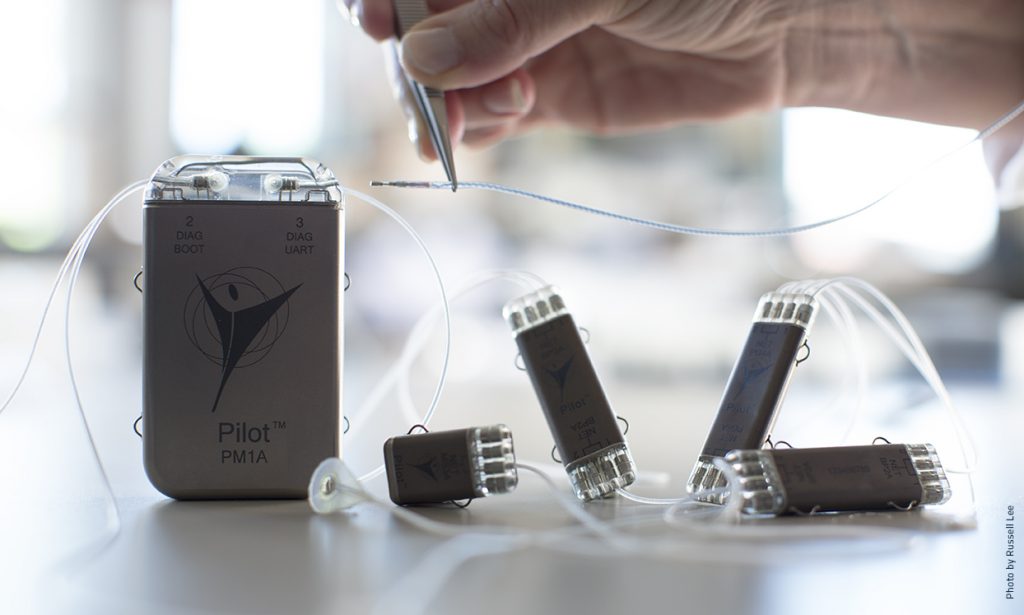Background
Neuroprosthetic devices are powerful tools providing life sustaining and functional enhancement for individuals with central nervous system disorders, such as spinal cord injury and stroke. In general, a neuroprosthetic system should provide:
- The robust functions that users demand
- Understandable and intuitive tools that clinicians need to implement those functions
- The technical transparency for surgeons to install the system successfully
- The power, flexibility, and upgradeability to meet the demanding and changing needs of researchers for continued development of new and improved functionality and control

Existing Implanted Neuroprosthetic Systems
- Utilize multiple implanted stimulus and sensing channels
- Require extensive external powering and signal processing
- “Centralized-link systems” a single implanted device forms the hub of a multi-channel system and all implanted components originate or terminate at this single location
- Each system must be customized to the specific application for which it is intended, making these devices “single application systems”
Limitations of Existing Neuroprosthetic Systems
- The fixed and inflexible architecture of centralized-link systems has several disadvantages:
- Limited flexibility in features, address only one disabling condition, and difficult to adapt to other applications without redesign and further development
- Difficult and costly to upgrade or expand – usually involves component removal and replacement
- Difficult to install for modest and complex applications
- Require donning external components for functional operation and cannot be used underwater while bathing/showering
The Networked Neuroprosthetic (NNP) System
- Neuroprosthesis capacity can be tailored to the individual’s needs
- Hardware is scalable from simple to complex applications
- Multiple disabilities can be addressed in a single individual
- Upgradeable – in hardware and/or software – to accommodate new technologies (upgrades)
- Adaptable to the changing needs of the user (functional enhancements)
- Frees the user from the need for external components – neuroprosthesis function is available spontaneously and in any environment
NNP SYSTEM components
- The NNP SYSTEM provides a portfolio of components that can be selected and connected in a “Plug ‘n’ Play” manner. Components include:
- Power Module – Provides the power source and power distribution to the Modules. The implanted power source is recharged via a transcutaneous
- inductive link. The Power Module incorporates a bidirectional wireless link used for monitoring and programming functions
- Actuator Modules – These are target-based: Muscle Stimulators, Nerve Stimulators etc.
- Sensor Modules – These are source-based: Biopotential, Transducer, etc.
- Network Cable – Provides the power and high-speed data connection for the Modules
- Electrodes – Appropriate stimulating and recording electrodes are used with the Modules
NNP SYSTEM as a Scalable Platform technology
- The modular architecture of the NNP SYSTEM is scalable to meet the technical needs of a broad range of neuroprosthetic applications
- Designed with an open architecture, providing the infrastructure to allow the development of new hardware, software, and control schemes and
- subsequent implementation in existing systems
- Provides an enabling platform technology upon which new clinical applications can be developed for a multitude of neurological disorders using a new stimulating and sensing neural interfaces, such as current steering, action-potential blocking, etc.
Clinical Application
- Neuroprosthesis capacity can be tailored to the individual’s needs and has complete flexibility in the configuration of stimulus (output) and sensor (input) channels
- The NNP SYSTEM has the ability to address multiple disabilities in a single individual
- Scalable to efficiently meet the requirements of simple through advanced systems
- The NNP SYSTEM can be expanded and upgraded after initial implantation without component removal
- Open architecture to accept new innovations. Rapidly incorporate new innovations by investigators (with backward compatibility)
- Powerful enough to allow advanced feedback and other control system techniques to be applied – e.g. autonomous control
Narrative

Upper Extremity FES System on Commercialization Path
